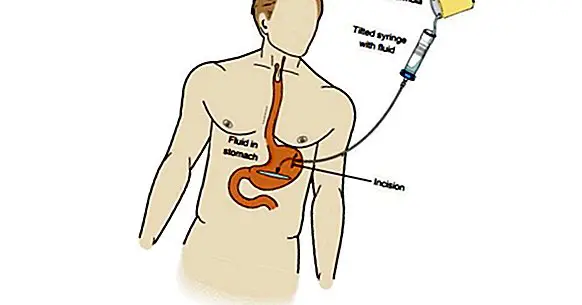Enteral nutrition: types, definition and uses with patients
In our daily life We are continuously ingesting food , several times a day, in most of the things without thinking about the complex process that we carry out both at a behavioral level.
But sometimes it is not possible to feed ourselves voluntarily: imagine that we are in a coma or that we suffer from some kind of disease that prevents us from eating. If nothing is done, the body would end up dying of starvation.
Fortunately, we have mechanisms that allow us to continue maintaining a supply of nutrients artificially: enteral nutrition .
- Related article: "Psychology of the feeding: definition and applications"
Enteral nutrition: what is it?
Enteral nutrition is, along with parenteral nutrition, one of the two types of artificial nutrition that we have in medicine. It is a support technique in which the different nutrients that the patient may need are introduced into the body, usually using a probe that goes directly to the intestine or stomach.
This technique avoids the need for food to pass through the mouth and trachea, not requiring voluntary movements to acquire the nutrients . However, applying enteral nutrition requires that the digestive system be able to exercise its normal functions when it comes to absorbing the nutrients supplied.
Enteral nutrition helps prevent, among other things, protein autocatabolism (In other words, the body consumes itself to obtain nutrients), the weakening of the immune system (with the consequent risk of infections), the bacterial translocation (that the bacteria of the digestive tract itself cause an infection) and the atrophy of the digestive system. The administration can be continuous or discontinuous according to the needs of the patient.
- You may be interested: "What is the difference between food and nutrition?"
Types of enteral nutrition
There are different methods by which enteral nutrition can be carried out. One of the ways to classify different types of enteral nutrition it is according to where the probe is placed and where it reaches.
1. Enteral nutrition by nasogastric tube
In this procedure, a tube that goes through the nose and goes to make a trip to the stomach , where the nutrients will be supplied. It is usually the most common mechanism, unless there is a risk of pulmonary aspiration of the contents of the intestine.
If the patient is conscious it will be introduced through the nostrils and he is going to be asked to swallow saliva in order to direct the tube to the digestive tract and not to the respiratory system. Despite this, the collaboration or awareness of the subject is not necessary to place it.
2. Enteral nutrition by nasoenteral tube
The procedure is the same as the previous one, except for the fact that in this case the probe will be taken to the intestine.
3. Enterostomy
When feeding through nasoenteric or nasogastric tube is not feasible there is another procedure: the enterostomy. In this case, a probe is not inserted through the usual routes, but is placed directly through the skin. More than a catheter, we would be facing a type of catheter. It is also used when the patient is expected to be unable to feed himself in more than four weeks. Within the enterostomies, three main techniques stand out.
- Maybe you're interested: "This is the chemical dialogue between your brain and your stomach"
Faringostomy
A probe is placed directly until it reaches the pharynx.
Gastrostomy
This procedure is based on the placement of a probe that reaches the stomach, but in this case crossing the skin .
Jejunostomy
Like the gastrostomy, a tube is inserted through the skin to reach the target organ, in this case the area of the intestine called the jejunum .
What kind of substances are introduced into the body?
Enteral nutrition involves introducing certain nutrients in the body, varying said substances according to the needs of the patient . They will vary if, for example, the patient has kidney or liver failure, diabetes, or respiratory problems. Also of the state of development of the subject (for example in babies breast milk is used). Among other things, the caloric and protein content (being hyper, normal or hypocaloric / protein) is taken into account.
As for the way in which nutrients are presented, in general we can find polymeric formulas (in which intact proteins are contributed), peptide (hydrolyzed proteins) or elemental (directly in the form of amino acids).There are also special diets for those patients with specific problems.
The most usual formula is the one that supposes a polymeric diet, normocalórica and normoproteica , but as we have already said the choice of components will depend on the patient and their needs.
In what cases does it apply?
Enteral nutrition is the technique of choice in all situations in which the patient presents malnutrition or risk of suffering due to the existence of the inability to swallow or the refusal to do so voluntarily, due to an injury, illness or mental disorder . In other words: it is used both in patients with no capacity to ingest, with a very diminished capacity or who refuse to do so despite having functional capacity for it.
However, in order to apply it, the digestive system must have a minimum of functionality when it comes to digesting and / or absorbing nutrients. It can be used in subjects of any age, from babies to the elderly.
It is essential in situations in which the subject does not have the ability to swallow , such as coma, or alterations of the pharynx that make it impossible to swallow.
It is also useful in some diseases in which although it has functional capacity to do so, the patient can not take it because of problems such as bronchodysplasia or heart disease. Or in which the intake is impossible because it causes reactions like vomiting . Another case occurs in situations in which the body needs more nutrients than the subject, despite eating, is able to provide.
On the other hand also It is recommended in premature babies , in order to prevent different diseases. Finally, it is used in mental disorders such as anorexia, forcing nutrition in cases of severe underweight that can lead to death,
Contraindications and risks
Enteral nutrition is a very beneficial technique that allows the body to supply the necessary nutrients when it can not ingest itself. However, in some cases this type of feeding may be contraindicated due to the existence of problems in the digestive tract itself.
The main contraindication occurs in the presence of obstructions, hemorrhages or perforations in stomach or intestine .
The use of enteral nutrition can also pose some risks. There may be obstructions or displacements of the probe or possible metabolic complications if an adequate diet has not been administered. Vomiting and nausea may occur, as well as diarrhea and reflux. Although it is rare, pulmonary aspiration of the contents of the digestive tract may occur.
Bibliographic references:
- Álvarez, J .; Peláez, N. and Muñoz, A. (2006). Clinical use of Enteral Nutrition. Hospital Nutrition, 21 (Supl.2); 87-99. Alcalá de Henares, Madrid.
- Lama, R.A. (s.f.). Enteral nutrition. Diagnostic and therapeutic protocols of Gastroenterology, Hepatology and Pediatric Nutrition. SEGHNP-AEP. Hospital Universitario de la Paz. Autonomous University of Madrid.
- Ostabal, M.I. (2002). Enteral nutrition Comprehensive medicine, 40 (7). 310-317. Elsevier



















